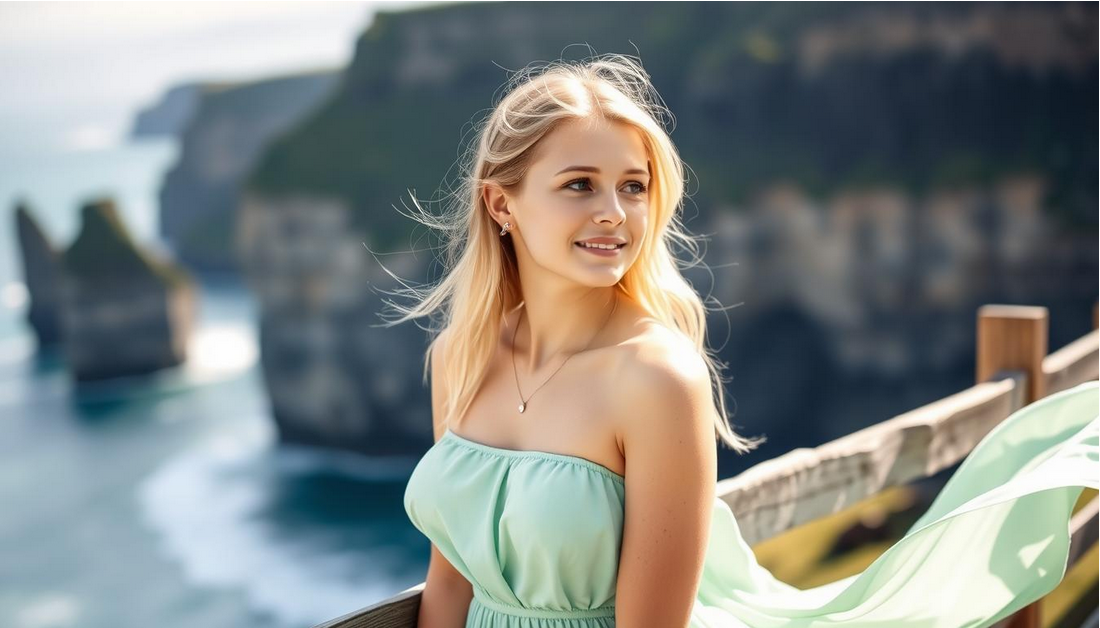Sunsets and Cliffs: Ireland’s Coastal Towns
Ireland’s coastal towns are a treasure trove of natural beauty, boasting breathtaking sunsets and dramatic cliffs that captivate the hearts of travelers.
- The Magical Allure of Ireland’s Coastline
- Sunsets and Cliffs: Ireland’s Coastal Towns at a Glance
- The Wild Atlantic Way: Ireland’s Premier Coastal Route
- Planning Your Journey Along the Wild Atlantic Way
- Must-See Stops and Viewpoints
- Driving Tips for American Visitors
- Iconic Cliff Destinations in Ireland
- The Majestic Cliffs of Moher in County Clare
- Slieve League: Europe’s Highest Sea Cliffs in Donegal
- Loop Head Peninsula and Its Lighthouse
- Top Coastal Towns for Sunset Viewing
- Dingle: Where Sunsets Paint the Harbor
- Doolin: Sunset Gateway to the Aran Islands
- Westport: Mayo’s Sunset Haven
- Hidden Gems Along Ireland’s Coastline
- Dunmore East: Waterford’s Coastal Secret
- Ardmore: Ancient History Meets Coastal Beauty
- Ballycotton: East Cork’s Dramatic Cliffs
- Coastal Cuisine: Seafood and Local Flavors
- Fresh Catch Restaurants with Ocean Views
- Traditional Irish Dishes with Coastal Twists
- Pub Culture in Seaside Towns
- Photographing Ireland’s Coastal Wonders
- Best Times and Conditions for Sunset Photography
- Equipment Tips for Cliff and Coastal Shots
- Iconic Frames and Compositions
- Coastal Activities and Experiences
- Cliff Walking Adventures and Marked Trails
- Boat Tours for Different Perspectives
- Local Festivals Celebrating Coastal Heritage
- Conclusion: The Timeless Beauty of Ireland’s Coastal Landscapes
- FAQ
- What are the best coastal towns in Ireland for watching the sunset?
- What is the Wild Atlantic Way, and how can I plan my journey along it?
- Are there any safety tips for exploring Ireland’s cliffs?
- What are some hidden gems along Ireland’s coastline that are worth visiting?
- What are the best times and conditions for photographing Ireland’s coastal wonders?
- What are some must-try Irish dishes with a coastal twist?
- How can I escape the tourist crowds when visiting Ireland’s coastal towns?
- What are some popular coastal activities and experiences available in Ireland?
- Are there any accessibility considerations for coastal activities in Ireland?
- What is the best time of year to visit Ireland’s coastal towns?

From the rugged Wild Atlantic Way to hidden gems along the coast, these towns offer a unique blend of picturesque landscapes and stunning coastal beauty. Whether you’re planning a trip or simply dreaming of Ireland’s serene landscapes, exploring these towns is a journey worth taking.
Key Takeaways
- Discover the most scenic coastal towns in Ireland
- Explore the Wild Atlantic Way and its hidden gems
- Experience the dramatic cliffs and breathtaking sunsets
- Find the best destinations for a serene coastal getaway
- Uncover the charm of Ireland’s coastal towns
The Magical Allure of Ireland’s Coastline
Ireland’s coastline is a masterpiece of natural artistry, shaped by centuries of geological activity and erosion. This unique landscape is characterized by its rugged cliffs, serene beaches, and picturesque villages, making it a captivating destination for travelers.
Where the Atlantic Meets Emerald Shores
The western edge of Ireland is where the mighty Atlantic Ocean meets the emerald shores, creating a dramatic and awe-inspiring landscape. The constant interaction between the sea and the land has sculpted a coastline that is both beautiful and harsh, with waves crashing against the cliffs and shores.

The Unique Coastal Geography of Ireland
Ireland’s coastline is distinguished by its unique geography, which includes dramatic cliffs, hidden coves, and expansive beaches. The geological history of the region has played a significant role in shaping this landscape.
Limestone Formations and Ancient Geology
The Irish coastline is home to fascinating limestone formations and ancient geological features. These formations tell the story of Ireland’s geological past, with evidence of the country’s complex tectonic history.
| Geological Feature | Description | Location |
|---|---|---|
| Limestone Formations | Unique rock formations shaped by erosion | Cliffs of Moher, County Clare |
| Ancient Cliffs | Cliffs formed through geological activity | Slieve League, County Donegal |
The combination of natural beauty and geological significance makes Ireland’s coastline a truly unique destination, offering something for everyone, from the casual visitor to the avid geologist.
Sunsets and Cliffs: Ireland’s Coastal Towns at a Glance
Ireland’s coastline is dotted with charming towns that showcase the country’s rich history and breathtaking scenery. These coastal towns are not just visually stunning; they also offer a deep dive into Ireland’s culture and heritage.
What Makes Irish Coastal Towns Special
Irish coastal towns are special for their unique blend of natural beauty and cultural richness. Towns like Dingle and Doolin are renowned for their vibrant music scenes and traditional Irish cuisine. The warm hospitality of the locals adds to the charm, making visitors feel at home.
Key Attractions in Irish Coastal Towns:
- Stunning sunsets over the Atlantic
- Dramatic cliffs and rugged coastlines
- Rich cultural heritage and history
- Vibrant music and arts scenes
- Delicious seafood and local cuisine
Best Seasons for Coastal Exploration
The best time to visit Ireland’s coastal towns depends on your preferences. Summer offers long days and a lively atmosphere, while the off-season provides a more peaceful experience.
Summer vs. Off-Season Experiences
Summer is ideal for those who enjoy bustling festivals and outdoor activities. In contrast, the off-season is perfect for those seeking tranquility and lower prices. Here’s a comparison:
| Season | Weather | Activities | Atmosphere |
|---|---|---|---|
| Summer | Mild, with temperatures around 18-22°C (64-72°F) | Festivals, surfing, hiking | Bustling, lively |
| Off-Season | Cooler, with temperatures around 8-12°C (46-54°F) | Cozy pub sessions, scenic drives | Peaceful, serene |
As one traveler noted, “The off-season in Ireland’s coastal towns is a hidden gem. The landscapes are just as breathtaking, and the locals are even more welcoming when it’s not crowded.”
“The wild Atlantic way is a journey that stays with you forever, a tapestry of landscapes that are both fierce and beautiful.”

Whether you choose to visit during the peak season or the off-season, Ireland’s coastal towns promise an unforgettable experience. With their stunning natural beauty, rich cultural heritage, and warm hospitality, these towns are sure to captivate any traveler.
The Wild Atlantic Way: Ireland’s Premier Coastal Route
Stretching along Ireland’s west coast, the Wild Atlantic Way offers a driving route like no other, filled with breathtaking coastal scenery. This 2,500-kilometer route is a journey through some of Ireland’s most stunning landscapes, from rugged cliffs to secluded beaches.
Planning Your Journey Along the Wild Atlantic Way
To make the most of your Ireland road trip, planning is key. Decide on the sections of the route you want to tackle, as the entire route can take several days to complete. Consider stops in charming coastal towns and villages, where you can experience local culture and cuisine.
- Research must-see attractions and book accommodations in advance, especially during peak travel seasons.
- Pack layers for unpredictable weather and comfortable shoes for exploring.
- Don’t miss the opportunity to try local seafood and traditional Irish dishes.

Must-See Stops and Viewpoints
The Wild Atlantic Way is dotted with coastal escapes that are not to be missed. From the Cliffs of Moher to the rugged coastline of County Donegal, each stop offers a unique perspective on Ireland’s natural beauty.
Top Stops:
- The Cliffs of Moher in County Clare
- Slieve League in County Donegal
- Loop Head Peninsula in County Clare
Driving Tips for American Visitors
For American visitors, driving on Ireland’s roads can be an adventure. Familiarize yourself with local driving laws and road signs. The route includes some narrow roads, so caution is advised.
Navigating Narrow Coastal Roads
When driving the Wild Atlantic Way, be prepared for narrow, winding roads. Take your time, and enjoy the views. It’s also a good idea to pull over at designated stops to take in the scenery and photograph the stunning landscapes.
Embarking on the Wild Atlantic Way is an unforgettable scenic drive experience that combines Ireland’s natural beauty with the adventure of exploring its wild coast. Whether you’re driving or cycling, this route promises an Ireland travel experience you’ll cherish forever.
Iconic Cliff Destinations in Ireland
Ireland is renowned for its stunning cliffs, a natural wonder that captivates all who see them. The country’s rugged coastline is home to some of the most spectacular cliff formations in the world, drawing visitors from far and wide.

The Majestic Cliffs of Moher in County Clare
The Cliffs of Moher are one of Ireland’s most iconic natural attractions. Standing 702 feet tall, these cliffs are a breathtaking sight, especially during sunset when the sky is painted with hues of orange and red. The cliffs are a haven for wildlife, with numerous species of seabirds calling them home.
Visitor Information: The Cliffs of Moher are open year-round, with visitor centers providing insights into the geology and history of the area.
Slieve League: Europe’s Highest Sea Cliffs in Donegal
Slieve League cliffs in County Donegal are another must-visit destination for cliff enthusiasts. Reaching heights of over 1,900 feet, they are among the highest sea cliffs in Europe. The cliffs offer breathtaking views of the Atlantic Ocean and the surrounding rugged landscape.
Exploring Slieve League: Visitors can hike along the cliffs, taking in the dramatic scenery and enjoying the tranquility of this less crowded destination compared to the Cliffs of Moher.
Loop Head Peninsula and Its Lighthouse
The Loop Head Peninsula in County Clare is known for its dramatic cliffs and historic lighthouse. The peninsula offers stunning views of the Shannon Estuary and the Atlantic Ocean. Visitors can explore the lighthouse, which provides insights into the maritime history of the area.
Safety Tips for Cliff Exploration
When exploring Ireland’s cliffs, safety should be a top priority. Here are some tips:
- Stay on marked paths to avoid erosion and ensure your safety.
- Be mindful of weather conditions, as strong winds and rain can make cliff edges slippery.
- Keep a safe distance from the cliff edges, especially with children.
| Cliff Destination | Height | Location |
|---|---|---|
| Cliffs of Moher | 702 feet | County Clare |
| Slieve League | 1,900 feet | County Donegal |
| Loop Head Peninsula | Varies | County Clare |
Top Coastal Towns for Sunset Viewing
Ireland’s coastline is home to numerous picturesque towns where visitors can witness stunning sunsets that paint the sky with vibrant hues. The experience of watching the sunset over Ireland’s coastal towns is truly unforgettable.

Dingle: Where Sunsets Paint the Harbor
Dingle, located on Ireland’s west coast, is famous for its vibrant harbor and stunning sunset views. As the day ends, the town’s colorful buildings are bathed in a warm, golden light, creating a picturesque scene.
Doolin: Sunset Gateway to the Aran Islands
Doolin is another coastal town that offers breathtaking sunset views. Known for its traditional Irish music sessions, Doolin is also a gateway to the Aran Islands, making it a perfect spot to watch the sunset before heading to the islands.
Westport: Mayo’s Sunset Haven
Westport, in County Mayo, is celebrated for its charming town square and scenic coastal walks. Visitors can enjoy a leisurely stroll along the Great Western Greenway, ending the day with a spectacular sunset view over Clew Bay.
Best Months for Clear Sunset Skies
The best months for clear sunset skies in Ireland are typically from May to September, when the weather is generally more settled. However, the shoulder season (April and October) can also offer clear skies and fewer crowds.
| Month | Average Clear Skies | Sunset Time |
|---|---|---|
| May | 60% | 9:00 PM |
| June | 65% | 9:30 PM |
| July | 70% | 9:30 PM |
| August | 65% | 8:30 PM |
| September | 60% | 7:30 PM |
By planning your visit during these months, you can maximize your chances of witnessing a clear and stunning sunset in Ireland’s coastal towns.
Hidden Gems Along Ireland’s Coastline
For those willing to venture off the beaten path, Ireland’s hidden coastal gems reveal their unique charm. Beyond the well-known destinations, the Irish coastline is home to numerous lesser-known towns and villages that offer a tranquil and authentic experience.
Dunmore East: Waterford’s Coastal Secret
Dunmore East, a picturesque fishing village in County Waterford, is a haven for those seeking a relaxed coastal experience. Its colorful harbor and scenic walking trails make it an ideal destination for nature lovers and those looking to unwind.
Ardmore: Ancient History Meets Coastal Beauty
Ardmore, in County Waterford, boasts not only stunning coastal views but also a rich history, with its ancient monastery and historic round tower. Visitors can enjoy the blend of natural beauty and historical significance in this charming village.
Ballycotton: East Cork’s Dramatic Cliffs
Ballycotton, located in East Cork, is known for its dramatic cliffs and lighthouse. It’s a perfect spot for those who enjoy dramatic coastal scenery and are looking for a less crowded alternative to more popular cliff destinations.
How to Escape the Tourist Crowds
To experience these hidden gems without the crowds, consider visiting during the shoulder season. Early morning and late evening visits can also help avoid peak tourist hours, allowing for a more peaceful and authentic experience.

Coastal Cuisine: Seafood and Local Flavors
Ireland’s coastline is not just a feast for the eyes, but also for the taste buds, offering an array of fresh Irish seafood and local flavors. The coastal towns are dotted with restaurants and pubs serving up delicious meals made from the freshest catches and locally sourced produce.
Fresh Catch Restaurants with Ocean Views
Imagine savoring a plate of freshly cooked seafood while gazing out at the Atlantic Ocean. Many restaurants along Ireland’s coast offer this unforgettable experience. For instance, The Fisherman’s Catch in Howth, County Dublin, is known for its seafood chowder and stunning views of the Irish Sea.
Traditional Irish Dishes with Coastal Twists
While traditional Irish cuisine is hearty and comforting, coastal towns have adapted these classics with a seafood twist. Dishes like seafood stew, Irish salmon, and seafood chowder are staples. In Dingle, County Kerry, you can find restaurants serving up innovative takes on traditional dishes, incorporating fresh local seafood.

Pub Culture in Seaside Towns
The pub culture in Ireland’s seaside towns is vibrant and welcoming. These pubs are not just places to enjoy a pint of Guinness; they’re also hubs for live music and delicious local cuisine. You can enjoy fresh oysters, crab, or lobster in a cozy atmosphere, surrounded by locals and visitors alike.
Food Festivals Along the Coast
Ireland’s coastal towns celebrate their culinary heritage with numerous food festivals throughout the year. The Galway Oyster Festival and Cork Midsummer Festival are just a couple of examples where you can sample the best of local flavors Ireland has to offer. These festivals are a great way to experience the rich pub culture Ireland and enjoy live music, local produce, and of course, plenty of Irish seafood.
Photographing Ireland’s Coastal Wonders
As the sun sets over Ireland’s Atlantic coast, photographers are treated to a display of color and light that is hard to match anywhere else in the world. Ireland’s coastline is a treasure trove of photographic opportunities, from the rugged landscapes to the dramatic cliffs and serene harbors.
Best Times and Conditions for Sunset Photography
The best time for sunset photography in Ireland is during the spring and early autumn when the skies are often at their most dramatic. Clear skies with a few scattered clouds can create breathtaking conditions, while stormy weather can add drama and intensity to your shots.
| Month | Sunset Time | Weather Conditions |
|---|---|---|
| March | 6:30 PM | Partly Cloudy |
| September | 7:30 PM | Mostly Sunny |
Equipment Tips for Cliff and Coastal Shots
For capturing Ireland’s dramatic cliffs and coastlines, a wide-angle lens is essential. A tripod will help stabilize your camera, especially in low light conditions. Don’t forget to pack extra batteries and memory cards, as the cold weather can quickly drain your battery.
“The best photographs are those that tell a story.”
— Ansel Adams
Iconic Frames and Compositions
When composing your shots, look for leading lines that draw the viewer’s eye to the subject, such as the lines of the cliffs or the shoreline. Consider using the rule of thirds to balance your composition.
Weather Considerations for Photographers
Ireland’s weather can be unpredictable. Always check the forecast before heading out and be prepared for changing conditions. Rain and fog can add mood to your photographs, but be sure to protect your equipment.

Coastal Activities and Experiences
Ireland’s coastline is a treasure trove of activities and experiences waiting to be discovered. Whether you’re an adventure seeker, a nature lover, or someone who appreciates cultural heritage, Ireland’s coastal towns have something for everyone.
Cliff Walking Adventures and Marked Trails
Ireland is renowned for its cliff walks and marked trails, offering breathtaking views of the Atlantic Ocean. The Cliffs of Moher Coastal Walk is a must-visit, with its well-marked trails and stunning vistas. For a more rugged experience, the Slieve League in County Donegal offers some of Europe’s highest sea cliffs.
- The Dingle Way trail offers a 179km route around the Dingle Peninsula, known for its vibrant cultural heritage and stunning landscapes.
- The Wild Atlantic Way is another significant route that spans the entire west coast, offering numerous cliff walks and scenic viewpoints.
Boat Tours for Different Perspectives
Exploring Ireland’s coastline from the sea offers a unique perspective on its natural beauty. Various boat tours are available, ranging from leisurely cruises to more adventurous sailing trips.
“Sailing along Ireland’s coast is like sailing through a dream. The rugged landscapes and vibrant sea life make for an unforgettable experience.” – A sailing enthusiast.
Local Festivals Celebrating Coastal Heritage
Ireland’s coastal towns are rich in cultural heritage, celebrated through various local festivals throughout the year. The Clare County’s Cliff Festival near the Cliffs of Moher is a notable event that combines music, food, and cliff walks.
Accessibility Information for Various Activities
Many of Ireland’s coastal activities are designed to be accessible to everyone. For instance, the Cliffs of Moher Visitor Center is fully wheelchair accessible, and some boat tours offer adapted facilities for visitors with mobility issues.
Conclusion: The Timeless Beauty of Ireland’s Coastal Landscapes
Ireland’s coastal towns have a way of captivating visitors with their breathtaking beauty. As we conclude our journey along the Wild Atlantic Way and beyond, it’s clear that the timeless charm of Ireland’s coastline is a treasure that continues to inspire travelers from around the world.
From the dramatic cliffs to the serene beaches, and from vibrant towns to hidden gems, Ireland’s coastline offers a diverse range of experiences that cater to all interests. Whether you’re planning an Ireland travel adventure or simply dreaming of the country’s scenic beauty, the Ireland views and Irish nature travel experiences are sure to leave a lasting impression.
For those looking to explore the best of Ireland, scenic drives Ireland offers a wealth of opportunities to discover the country’s most stunning landscapes. And when it comes to coastal escapes Ireland, the options are endless, from relaxing in seaside towns to exploring the rugged coastline.
FAQ
What are the best coastal towns in Ireland for watching the sunset?
Some of the top coastal towns in Ireland for watching the sunset include Dingle, Doolin, and Westport, each offering a unique setting and breathtaking views.
What is the Wild Atlantic Way, and how can I plan my journey along it?
The Wild Atlantic Way is one of Ireland’s most iconic routes, stretching along the west coast. To plan your journey, research must-see stops, viewpoints, and driving tips, and consider renting a car or booking a guided tour.
Are there any safety tips for exploring Ireland’s cliffs?
Yes, when exploring Ireland’s cliffs, stay on marked trails, keep a safe distance from the edge, and be mindful of weather conditions to ensure a safe and enjoyable experience.
What are some hidden gems along Ireland’s coastline that are worth visiting?
Some hidden gems along Ireland’s coastline include Dunmore East, Ardmore, and Ballycotton, each offering a unique blend of natural beauty, history, and culture.
What are the best times and conditions for photographing Ireland’s coastal wonders?
The best times for photographing Ireland’s coastal wonders include during sunrise and sunset when the light is soft, and on overcast days when the clouds add drama to the scenery.
What are some must-try Irish dishes with a coastal twist?
Some must-try Irish dishes with a coastal twist include fresh seafood chowder, Irish smoked salmon, and seafood paella, often featuring locally caught ingredients.
How can I escape the tourist crowds when visiting Ireland’s coastal towns?
To escape the tourist crowds, consider visiting during the off-season, exploring lesser-known towns and villages, and venturing off the beaten path to discover hidden gems.
What are some popular coastal activities and experiences available in Ireland?
Popular coastal activities and experiences in Ireland include cliff walking, boat tours, surfing, and kayaking, as well as attending local festivals that celebrate Ireland’s coastal heritage.
Are there any accessibility considerations for coastal activities in Ireland?
Yes, some coastal activities in Ireland have accessibility considerations, such as wheelchair-accessible paths and adapted facilities, so it’s best to research and plan ahead to ensure a smooth experience.
What is the best time of year to visit Ireland’s coastal towns?
The best time to visit Ireland’s coastal towns depends on your preferences, but summer offers warm weather and long days, while spring and autumn provide mild temperatures and fewer crowds, and winter is ideal for storm watching and cozying up in local pubs.








